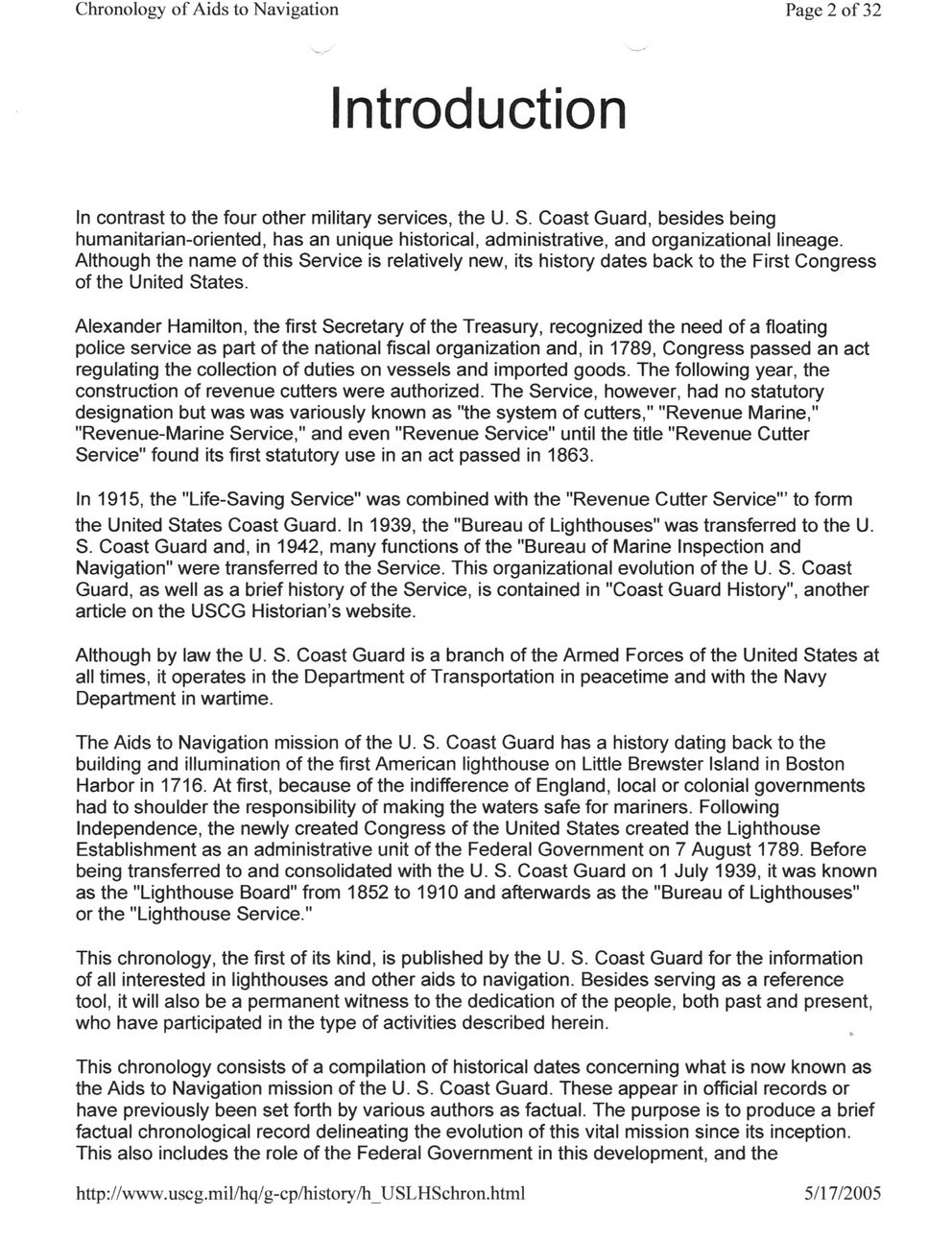This text was obtained via automated optical character recognition.
It has not been edited and may therefore contain several errors.
Chronology of Aids to Navigation Page 2 of 32 Introduction In contrast to the four other military services, the U. S. Coast Guard, besides being humanitarian-oriented, has an unique historical, administrative, and organizational lineage. Although the name of this Service is relatively new, its history dates back to the First Congress of the United States. Alexander Hamilton, the first Secretary of the Treasury, recognized the need of a floating police service as part of the national fiscal organization and, in 1789, Congress passed an act regulating the collection of duties on vessels and imported goods. The following year, the construction of revenue cutters were authorized. The Service, however, had no statutory designation but was was variously known as "the system of cutters," "Revenue Marine," "Revenue-Marine Service," and even "Revenue Service" until the title "Revenue Cutter Service" found its first statutory use in an act passed in 1863. In 1915, the "Life-Saving Service" was combined with the "Revenue Cutter Service"’ to form the United States Coast Guard. In 1939, the "Bureau of Lighthouses" was transferred to the U. S. Coast Guard and, in 1942, many functions of the "Bureau of Marine Inspection and Navigation" were transferred to the Service. This organizational evolution of the U. S. Coast Guard, as well as a brief history of the Service, is contained in "Coast Guard History", another article on the USCG Historian’s website. Although by law the U. S. Coast Guard is a branch of the Armed Forces of the United States at all times, it operates in the Department of Transportation in peacetime and with the Navy Department in wartime. The Aids to Navigation mission of the U. S. Coast Guard has a history dating back to the building and illumination of the first American lighthouse on Little Brewster Island in Boston Harbor in 1716. At first, because of the indifference of England, local or colonial governments had to shoulder the responsibility of making the waters safe for mariners. Following Independence, the newly created Congress of the United States created the Lighthouse Establishment as an administrative unit of the Federal Government on 7 August 1789. Before being transferred to and consolidated with the U. S. Coast Guard on 1 July 1939, it was known as the "Lighthouse Board" from 1852 to 1910 and afterwards as the "Bureau of Lighthouses" or the "Lighthouse Service." This chronology, the first of its kind, is published by the U. S. Coast Guard for the information of all interested in lighthouses and other aids to navigation. Besides serving as a reference tool, it will also be a permanent witness to the dedication of the people, both past and present, who have participated in the type of activities described herein. This chronology consists of a compilation of historical dates concerning what is now known as the Aids to Navigation mission of the U. S. Coast Guard. These appear in official records or have previously been set forth by various authors as factual. The purpose is to produce a brief factual chronological record delineating the evolution of this vital mission since its inception. This also includes the role of the Federal Government in this development, and the http://www.uscg.mil/hq/g-cp/history/h_USLHSchron.html 5/17/2005

Lighthouses Chronology-of-Aids-to-Navigation-(02)